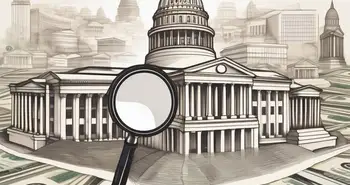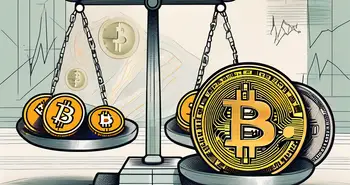Modern Monetary Theory (MMT): An Overview

Welcome to The Ultimate Guide to Modern Monetary Theory (MMT). As an expert in the field, I'm here to break down the fundamentals of MMT, explore its implications for the government and private sector, address common criticisms, and delve into its real-world applications. Let's dive in and uncover the inner workings of this fascinating economic theory.
Understanding the Basics of Modern Monetary Theory
Before we delve into the intricacies of Modern Monetary Theory, let's clarify what exactly it is. At its core, MMT challenges the conventional wisdom of government spending and debt. It proposes that a sovereign government, which controls its own currency, can fund its spending by simply creating new money.
What is Modern Monetary Theory?
Modern Monetary Theory, in essence, argues that governments that issue their own currency do not face the same financial constraints as households or businesses. It asserts that these governments can create money to spend, allowing them to pursue full employment and social welfare goals.
The Core Principles of MMT
At the heart of Modern Monetary Theory lies a set of principles that distinguish it from traditional economic theories. These key principles include:
- Governments with monetary sovereignty can create money at will.
- Taxes serve a purpose beyond funding government spending, primarily to ensure the stability of the currency and control inflation.
- The government should focus on achieving full employment rather than solely controlling inflation.
- Government deficits are not inherently bad and can serve as a way to boost economic activity.
The Origins and Evolution of MMT
Modern Monetary Theory has historical roots, but it gained prominence in the aftermath of the Global Financial Crisis in 2008. Economists like L. Randall Wray, Stephanie Kelton, and Warren Mosler played significant roles in developing and popularizing MMT. Since then, it has garnered attention from policymakers, economists, and the public alike.
One of the key influences on the development of Modern Monetary Theory was the work of economist Abba Lerner. Lerner's theory of functional finance, which he proposed in the 1940s, laid the groundwork for many of the ideas that form the basis of MMT today. His argument that the primary purpose of government spending should be to achieve full employment rather than balancing the budget resonated with proponents of MMT.
Since the Global Financial Crisis, MMT has faced both praise and criticism. Supporters argue that it offers a fresh perspective on economic policy and provides a framework for governments to address pressing social issues. Critics, on the other hand, express concerns about the potential for inflation and the long-term sustainability of government deficits. Despite the ongoing debate, MMT continues to shape economic discussions and influence policy decisions around the world.
The Role of Government in MMT
Now that we have a grasp of the basic tenets of Modern Monetary Theory, let's explore the implications for government operations.
Modern Monetary Theory (MMT) is a macroeconomic framework that challenges conventional beliefs about government spending, taxation, and debt. It posits that a sovereign government that issues its own currency can never run out of money and can always meet its financial obligations. This unique perspective has significant implications for how governments operate and manage their economies.
Government Spending and MMT
In the MMT framework, government spending is not limited by revenue or borrowing. It can create money by simply crediting the bank accounts of individuals, businesses, or even itself. This ability empowers governments to fund infrastructure projects, social welfare programs, and other initiatives without relying on tax revenue or borrowing.
This approach to government spending opens up new possibilities for addressing societal needs and promoting economic development. By leveraging its currency-issuing power, a government can invest in areas that traditional economic models might deem financially unfeasible. This flexibility allows for a more proactive and responsive approach to addressing challenges such as unemployment, inequality, and climate change.
Taxation in the MMT Framework
Taxes in MMT play a different role than traditionally believed. They are not solely for funding government spending; rather, they control the economy by reducing the money supply and influencing consumer behavior. Taxes help maintain price stability and prevent inflationary pressures.
Furthermore, MMT suggests that the government can use taxation as a tool to promote social equity and address income disparities. By implementing progressive tax policies that target the wealthy and corporations, the government can redistribute wealth and ensure a more equitable distribution of resources. This approach aligns with the principle of using fiscal policy not just for economic stability but also for social justice and welfare.
Debt and Deficit in Modern Monetary Theory
Contrary to popular belief, MMT doesn't see government debt as an immediate danger. As long as a country issues its own currency and has control over monetary policy, it can effectively manage its debt. Moreover, MMT argues that deficits can be beneficial for an economy, as they inject money into circulation and stimulate economic growth.
By viewing deficits not as inherently negative but as a tool for achieving broader economic objectives, MMT challenges the prevailing narrative around government debt. This perspective encourages policymakers to focus on the real resources and productive capacity that deficits can mobilize, rather than fixating on arbitrary debt-to-GDP ratios. It underscores the importance of directing fiscal policy towards achieving full employment, price stability, and sustainable growth, rather than fixating on achieving a balanced budget at all costs.
MMT and the Private Sector
While MMT primarily focuses on government operations, it also has implications for businesses and individual finances.
How MMT Affects Businesses
Under MMT, businesses may witness increased government spending in areas such as infrastructure, healthcare, and education. This injection of funds can create new opportunities and stimulate economic activity, potentially benefiting businesses across various sectors.
MMT's Impact on Individual Finances
On an individual level, MMT challenges the notion of balancing budgets. It suggests that individuals can benefit from government spending on job creation and social programs, leading to improved economic conditions, higher wages, and increased purchasing power.
Criticisms and Controversies Surrounding MMT
As with any economic theory, Modern Monetary Theory has faced criticism and generated heated debates among economists and policymakers.
Common Misconceptions about MMT
One common misconception is that MMT promotes unlimited government spending without consequences. However, MMT advocates emphasize that fiscal responsibility and careful management of inflationary pressures are crucial.
Critiques from Economists and Policy Makers
Economists and policymakers have raised concerns regarding potential inflation, interest rate volatility, and the risk of excessive government control over the economy. They argue that MMT's assumptions may not hold up in real-world scenarios.
MMT in Practice
As MMT gains recognition and influence, policymakers are exploring its practical applications in shaping economic policy.
MMT and Economic Policy
Proponents of MMT suggest that this theory could offer new avenues for governments to address economic challenges, such as achieving full employment, reducing income inequality, and funding public investments. However, the practical implementation of MMT remains a subject of ongoing research and debate.
The Future of MMT: Predictions and Possibilities
As an expert in Modern Monetary Theory, I see immense potential for MMT to reshape economic thinking and policy discussions in the years to come. While it faces valid criticisms and uncertainties, its alternative approach to government spending, taxes, and deficits opens up avenues for exploring new solutions to economic challenges.
Personal Expert Advice: So, whether you find yourself embracing or questioning MMT, I urge you to keep an open mind and continue to explore how it may reshape our understanding of economic systems. Understanding diverse economic theories is crucial for informed decision-making, and Modern Monetary Theory is undoubtedly a prominent and thought-provoking player in the field.
FAQs
What is Modern Monetary Theory?
Modern Monetary Theory challenges the traditional view of government spending and debt by asserting that a sovereign government can create money to fund its spending.
How does MMT differ from traditional economic theories?
MMT distinguishes itself from traditional economic theories by emphasizing that governments with monetary sovereignty have greater flexibility in managing their deficits, taxes, and spending.
What are the core principles of MMT?
The core principles of MMT include the government's ability to create money, the multifaceted role of taxes, the priority of full employment, and the potential benefits of government deficits in stimulating economic growth.
How does MMT impact businesses and individuals?
MMT can impact businesses by increasing government spending in various sectors, potentially creating new opportunities. For individuals, MMT challenges conventional notions of balancing budgets and promotes the idea of government spending on job creation and social programs to improve economic conditions.
What are the common criticisms of MMT?
Common criticisms of MMT revolve around concerns of inflation, interest rate volatility, and the potential risk of excessive government control over the economy.
Can MMT be practically applied in economic policy?
MMT is being studied and considered by policymakers as a framework to address economic challenges such as full employment, income inequality, and public investment. However, its practical implementation remains an ongoing area of research and debate.
What is the future of MMT?
The future of MMT is filled with possibilities and predictions. As economic thinking continues to evolve, MMT could play a significant role in shaping policy discussions and challenging traditional economic assumptions.
Now that you've gained a deeper understanding of Modern Monetary Theory, I encourage you to explore further and engage in the ongoing dialogues surrounding this captivating economic framework. Together, we can continue to unravel the complexities of our financial systems and seek innovative solutions for a prosperous future.
As you contemplate the insights from Modern Monetary Theory and consider its potential impact on the future of finance, why not take a proactive step towards innovative investment? Morpher.com invites you to experience the next generation of trading, where blockchain technology meets limitless opportunities across diverse markets. Embrace a world where zero fees, infinite liquidity, and fractional investing are the norm. Sign Up and Get Your Free Sign Up Bonus today, and join the forefront of financial evolution with Morpher.

Disclaimer: All investments involve risk, and the past performance of a security, industry, sector, market, financial product, trading strategy, or individual’s trading does not guarantee future results or returns. Investors are fully responsible for any investment decisions they make. Such decisions should be based solely on an evaluation of their financial circumstances, investment objectives, risk tolerance, and liquidity needs. This post does not constitute investment advice.

Painless trading for everyone
Hundreds of markets all in one place - Apple, Bitcoin, Gold, Watches, NFTs, Sneakers and so much more.

Painless trading for everyone
Hundreds of markets all in one place - Apple, Bitcoin, Gold, Watches, NFTs, Sneakers and so much more.









